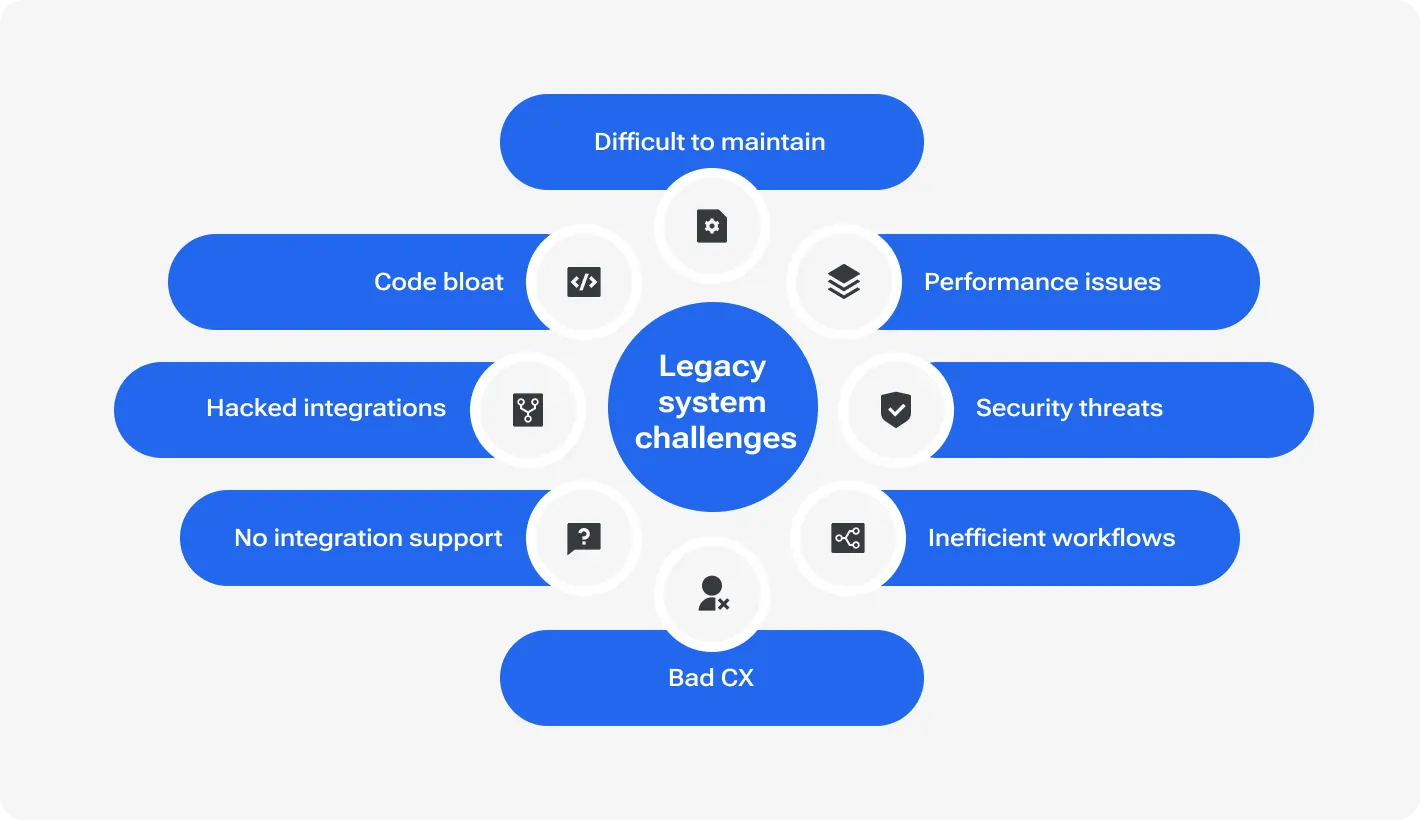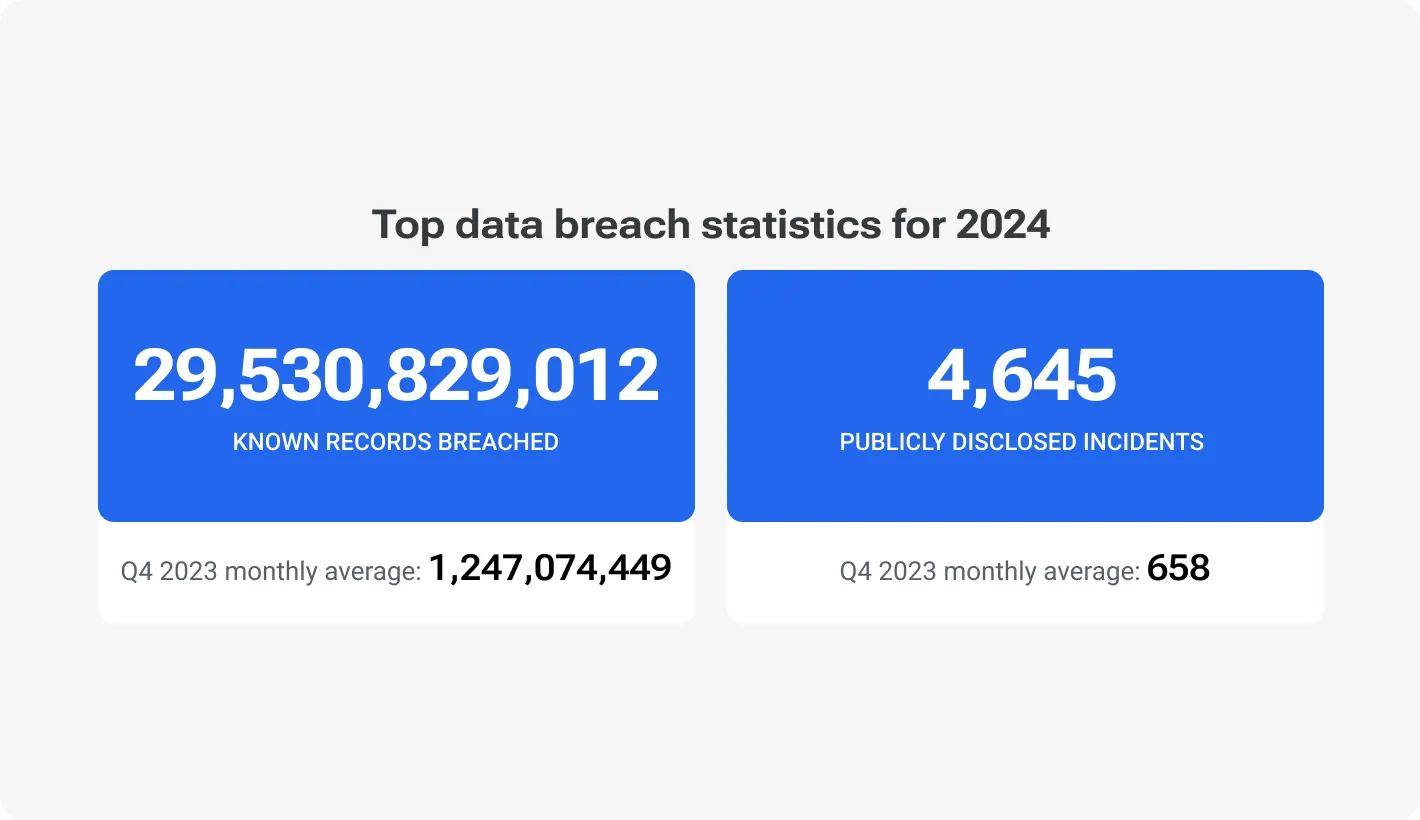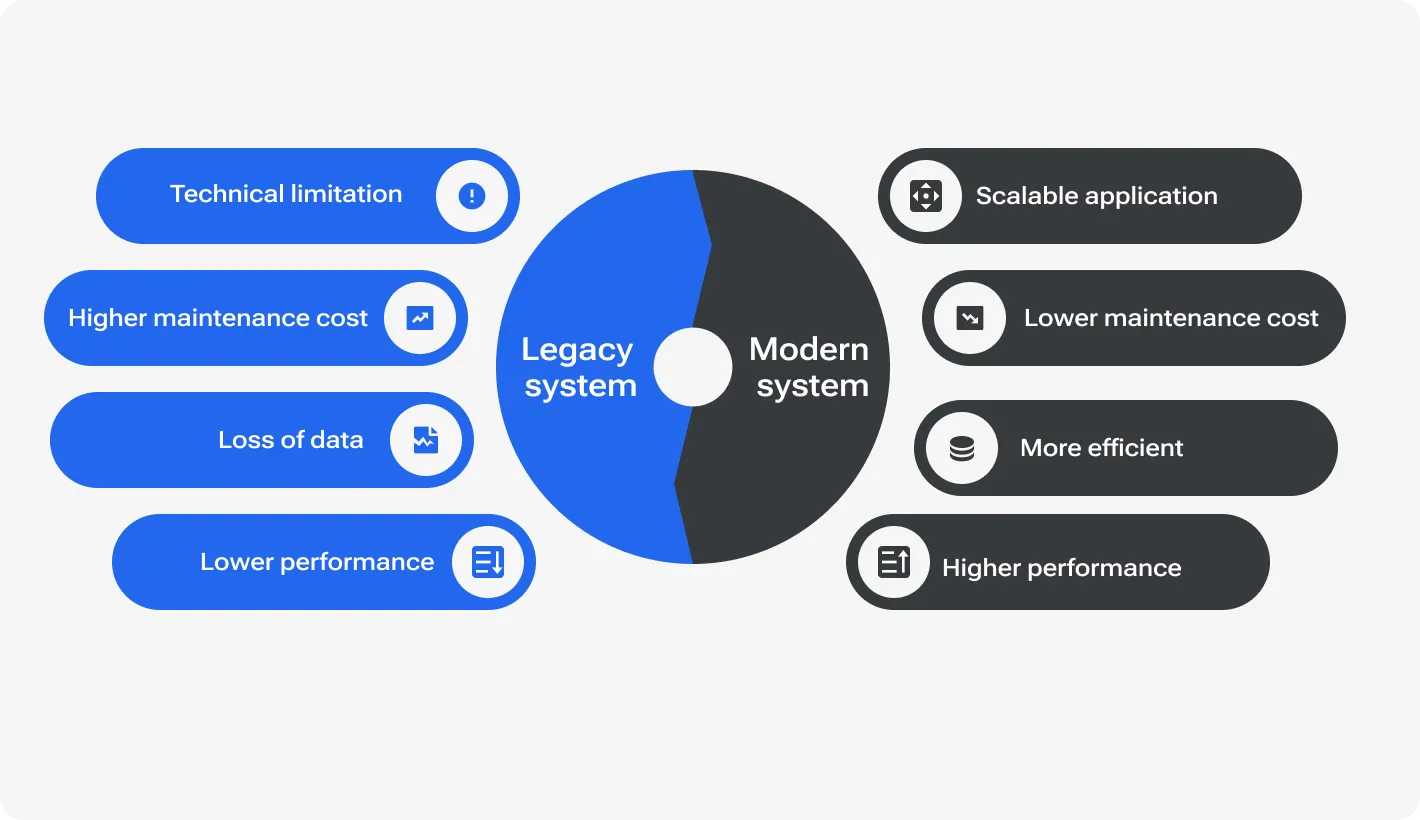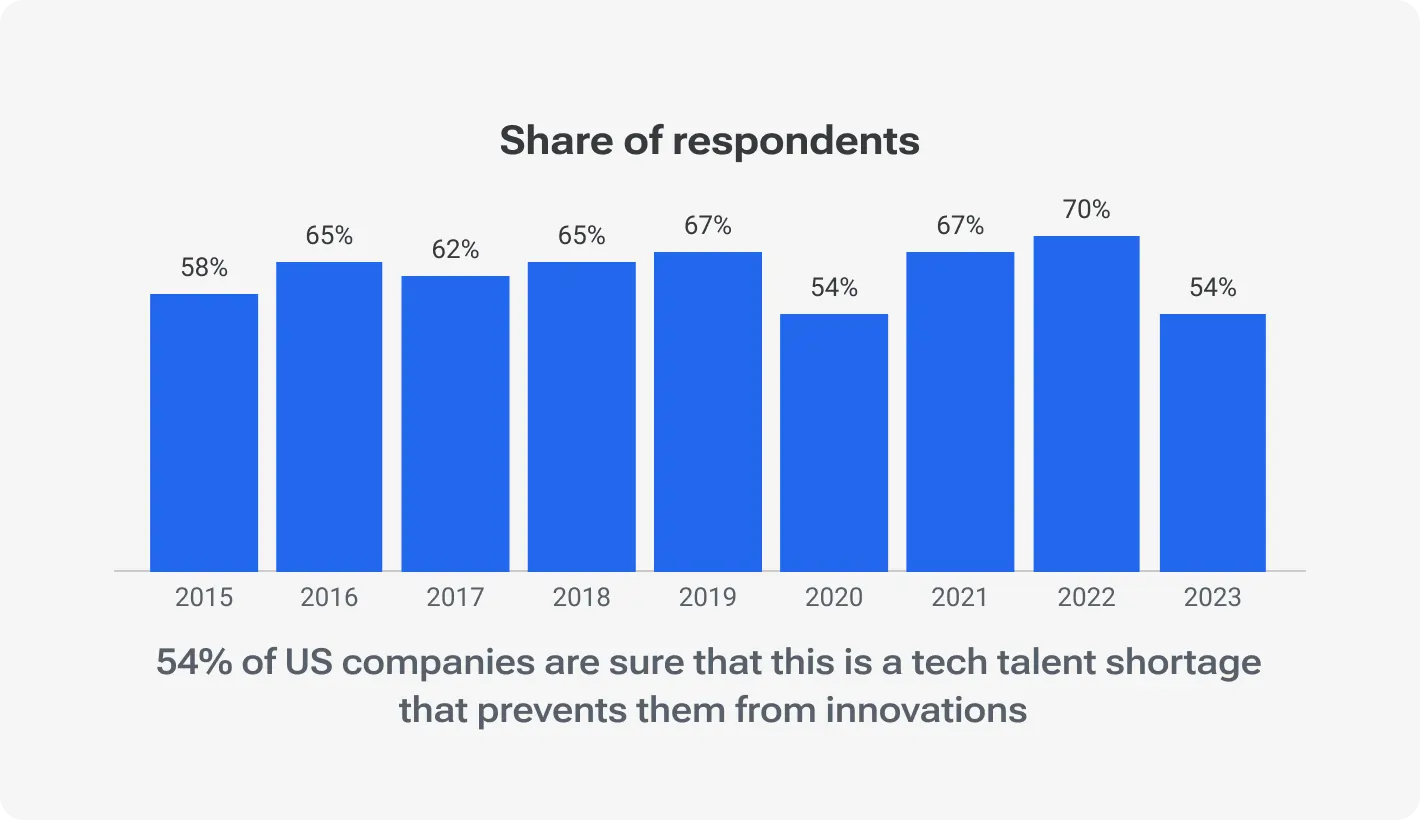Remember Blockbuster? The dominating video rental giant fell because of the streaming services rise. And especially because of its reliance on an outdated legacy inventory management system. While “newcomers” like Netflix were scaling their cloud-based platform, Blockbuster was stuck on a clunky, on-premise system, leading to inefficiencies, lost customers, and, ultimately, its demise.
Not a unique story, but insightful, though. Businesses worldwide are burdened by legacy systems and software applications built on antiquated technologies that are slow, insecure, and incompatible with modern tools. They might still function, but they're keeping you back from innovating, competing, and thriving.
The U.S. government, for instance, spends about 80% of its IT budget on maintaining these legacy behemoths, according to a 2021 report by the U.S. Government Accountability Office (GAO). That money could be used for cutting-edge solutions development and digital transformation, but instead, it's stuck in the IT equivalent of a museum exhibit.
But the solution is simple — legacy application modernization. It's the process of transforming these outdated systems into sleek, cloud-native applications. Legacy systems, characterized by outdated hardware and cumbersome architectures, present significant obstacles to businesses striving for agility and competitiveness — just barriers to innovation and growth.
Scale your business effortlessly with modernized IT solutions
Enter legacy modernization; revitalization and modernizing your legacy process improves customer experiences and drives sustainable growth. This is why modernization is so critical. And because the numbers speak loudly.
By the way, in March 2023, IDC rolled out their study — companies that embrace modernization experience a mind-blowing 223% return on investment (ROI) within three years.
In this article, we’ll guide you on how to modernize legacy applications.
Understanding Legacy Systems
From the intro, one might realize that legacy systems are something from the age of dinosaurs. But the reality is much more nuanced. It is not a question of the age of the system in use but rather of its inability to cover the specific needs of a particular business.
But we can’t help but admit that legacy systems are typically marked by out-of-date architecture, obsolete technologies, and limited interoperability with contemporary solutions. Yeah, they were significant and effective in the past, but legacy systems now present considerable challenges to any company adapting to rapidly evolving business environments.
These systems were often developed using programming languages and frameworks that are no longer widely supported or understood by modern developers. Consequently, making changes or enhancements to these systems can be laborious and costly, often requiring specialized expertise that may be in short supply.
Moreover, without the modernization of legacy applications, such companies experience a lack of flexibility and scalability. This inflexibility also results in longer lead times for implementing changes and, hence, slower time-to-market.
Common Challenges Associated with Legacy Systems
Security Concerns
First and foremost — security issues. As of the start of 2024, there were over 10 significant data breaches, with 16M+ records leaked in each case. Outdated software components may contain known vulnerabilities that are no longer patched or supported by vendors, leaving organizations exposed to potential risks. Additionally, legacy systems may lack modern security features and protocols, further exacerbating their susceptibility to threats.
Interoperability Issues
Inter-oper-ability is the ability of different systems, programs, or devices to operate as if they were in a single environment and exchange data without interference. For example, interoperability within iOS and Windows (it exists) allows users to exchange data without problems. And yes, this aspect is another challenge posed by legacy systems. In today's interconnected business landscape, organizations rely on seamless data exchange and integration between disparate systems and applications. Yet, legacy systems often operate in isolation, incompatible with modern APIs and standards.
Innovation, Costs, and Talent Scarer
Heavy roadblocks to implementing new technologies and processes hinder your ability to innovate and stay ahead of the curve. In addition, the constant maintenance and integration efforts drain resources that could be better invested in modern solutions. And last but not least, finding skilled professionals who can (and are willing to) maintain and manage these outdated systems can be difficult and expensive.
What is Legacy Application Modernization?
Think of your IT infrastructure as a city. Some buildings are sleek, modern skyscrapers. Others are aging brick-and-mortar structures, charming but creaky, struggling to keep pace with the evolving landscape. Legacy modernization software is the process of transforming those outdated structures into vibrant, cloud-powered hubs, revitalizing your “IT city”.
While we use the concept of legacy modernization approach, there is an entire spectrum of approaches, in fact, from rehosting systems on the cloud to completely rebuilding them using modern technologies.
How Many Companies Are Adopting Modernization?
IDC states that approximately 70% of companies in the United States are actively modernizing legacy applications to stay competitive in today's digital landscape. And it’s a remarkable highlight of widespread recognition among businesses of the critical importance of modernizing outdated systems to drive growth.
By the way, IDC’s study is echoed by the 2020 Forrester study, with 62% of US businesses actively engaged in legacy modernization initiatives. That's another sign that businesses recognize the imperative of shedding the digital deadweight and embracing agility in the face of rapid technological change.
Examples of Legacy Application Modernization Projects
Let’s give some conditional examples to set out the nuances of IT legacy modernization across different industries.
- Streamlining Customer Onboarding in the Banking Industry:
We have a big-sized US bank. Since the fintech industry is a very strict and regulated one, banks don’t release renewal software too often. And this, in turn, leads to the situation when they are burdened by complex legacy systems, especially for those related to customer onboarding features. But then, they rehosted certain functionalities on the cloud for improved scalability and security while modernizing critical components with microservices architecture. This can result in a significant reduction in onboarding time and, hence, an increase in customer satisfaction.
- Retail Chain Revamps Inventory Management:
Another “victim” — a retail chain struggling with an inflexible legacy inventory system. In the lookout for improvements, they rebuilt the system using a cloud-based, API-driven architecture. This enabled real-time inventory tracking, improved demand forecasting, and a particular reduction in out-of-stock situations. As a consequence, this leads to happier customers and increased sales.
- Patient Engagement:
And the last example — a healthcare provider facing an outdated patient portal built on a legacy platform. After a tech strategic session, they undertook a microservices modernization project. Tech leaders modularized the portal into smaller, agile components, allowing for faster development and deployment of new features. This can increase patient portal usage and improve communication with healthcare providers.
Why Modernize Legacy Applications?
Transformation of British Airways' booking system is a spark example of legacy systems modernization. At that moment, the potential failure dawned on Airways’ board. Mounting challenges with its outdated legacy system forced British Airways to embark on a modernization journey. The legacy system, which was over many years old, struggled to cope with the increasing demands of modern air travel. As a result, there were frequent outages, delays, and frustrated customers.
Through a comprehensive modernization effort, British Airways migrated its booking system to a modern, cloud-native architecture, leveraging microservices and containerization to improve scalability and reliability. At the end of the day, the company modernized the booking system, reduced downtime by 90%, increased transaction processing speed by 300%, and improved overall system stability by over 90%. These improvements brought about tangible benefits for both the airline and its customers, with an increase in booking conversions and a significant reduction in customer complaints.
Benefits of Modernizing Legacy Applications
Enhanced Performance and Scalability
This move enables companies to leverage advanced technologies and architectures that improve performance and scalability. To be precise, migration to cloud-native platforms and adoption of microservices architecture, for example. This way, any company can accommodate growing workloads and seamlessly scale their applications to meet evolving demands.
Improved Security and Compliance
Legacy systems make you the easiest target for cyber crooks through security vulnerabilities. And this is not to mention compliance risks and lack of modern security features. Modernizing legacy applications allows companies to implement robust security measures (encryption, access controls, and threat detection mechanisms, etc.) to protect sensitive data and comply with regulatory requirements.
Cost Savings and Operational Efficiency
Legacy systems incur high maintenance costs and operational overhead due to their complexity and outdated infrastructure. By modernizing legacy applications, organizations can streamline operations, automate manual tasks, and reduce IT maintenance costs, resulting in significant cost savings and improved operational efficiency.
Enhanced User Experience
Among other benefits, we can’t help but mention probably the main one — companies can deliver a superior user experience by implementing intuitive interfaces, optimizing performance, and personalizing interactions. Enhance usability and accessibility, and you’ll be able to increase user satisfaction and loyalty, which inevitably will bring about positive business outcomes.
Competitive Advantage in Action
Take the transformation of Walmart's supply chain management system as a next case-proof example. Facing intense competition and pressure to deliver goods faster and more efficiently, Walmart modernized its legacy supply chain management system to improve agility and responsiveness to market demands.
Leveraging advanced analytics, real-time data insights, and automation technologies made Walmart’s supply chain operations well-optimized, reducing inventory costs, minimizing stockouts, and improving product availability. This, in turn, allowed the giant to gain a competitive edge in the retail market.
How outdated legacy systems slow down business growth & ways to overcome it
When is the Right Time for Modernizing Legacy Applications?
Well, there are two ways you can dive into when it comes to legacy modernisation. You can either ignore it and fall behind the market leaders or accept a challenge and stay ahead of the curve. But remember, ignoring the call for legacy application modernisation is akin to driving a vintage car with square wheels on a modern highway — weird, dangerous, and destined for a bumpy ride. But how do you know when it's time to embrace the cloud-powered future? Here are some obvious signs.
Outdated Technology and Infrastructure
Aging systems built on obsolete platforms and hardware often struggle to keep pace with the demands of modern business operations. A recent report by Gartner found that 50% of business-critical applications are still built on legacy technologies, struggling to keep pace with the rapid evolution of security standards, development tools, and cloud platforms. It's like trying to run a marathon in flip-flops — funny but inefficient.
Inability to Meet Evolving Business Requirements
Legacy applications may fail to adapt to changing business requirements and customer expectations. This way, they decrease your efficiency and competitiveness. McKinsey states that companies struggling with legacy systems are more likely to fall behind competitors in terms of innovation and customer satisfaction. It’s pretty frustrating and unproductive since it hinders your ability to adapt and grow.
Rising Maintenance Costs and Declining Performance
Your legacy systems age, and so do maintenance costs. They tend to rise while performance declines. A 2020 IDC report found that organizations spending over 80% of their IT budgets on maintaining legacy systems often experience performance bottlenecks and security vulnerabilities. And contrastingly, companies leveraging cloud platforms raise their ROI by up to 222%. You can either pour money into a leaky bucket or invest in your future.
Strategic Considerations for Timing Legacy Modernization Efforts
Business Priorities
Want to achieve the level of ROI mentioned in the previous passage? Then align your modernization efforts with strategic business priorities. The entire company should assess its current and future business needs to determine the optimal timing for modernization initiatives.
Market Dynamics and Competitive Landscape
Monitor, analyze, and adapt. Keeping an eye on market trends and competitive pressures will help you identify opportunities and threats that necessitate modernization. The 2021 Thoughtwork-sponsored research by Harvard Business Review Analytic Services found that the lion's share of executives consider legacy modernization essential foremost for maintaining competitiveness.
Technology Readiness
We can’t help but admit — you must be ready for modernization. Otherwise, this will be a story about the leaky bucket from the passage above. Evaluate your readiness for emerging technologies and innovation trends — this serves as the best decision-making beacon. Today, almost any middle-sized or big company should leverage advancements in cloud computing, AI, and automation to drive efficiency.
What to Expect from Legacy Modernization?
Many spiritual teachers say that all human misery is from inflated expectations. We are not spiritual teachers, but we, too, realize the importance of correct expectations, particularly in legacy modernization.
Key Outcomes and Expectations
Seamless Integration with Existing Systems: The most important rule should be like doctors’ — do no harm. Seamless integration of modernized applications with existing systems and infrastructure is paramount. Zero in on interoperable architectures and standardized protocols as this way, you can ensure smooth data exchange and interoperability between legacy and modernized systems.
Minimal Disruption to Ongoing Business Operations: Almost every middle-sized company must have a BCP, business continuity plan. With it, it’s much easier to implement robust change management strategies and minimize downtime.
User Experience Must Improve: Any projects related to legacy modernization must bring about improved user experience and productivity. Several moves can lead to such outcomes: redesigning user interfaces, optimizing workflows, incorporating intuitive features — you and your team can empower users to accomplish tasks more efficiently and effectively.
Challenges and Potential Roadblocks
Technical Debt and Complexity:
When it comes to the modernization of legacy applications, the first thing that you’ll encounter is a complex architecture and (with a high probability) accumulated technical debt. And a risk pops up there — your modernization efforts can go down the drain. So, plan carefully and execute flexibly.
Skill Gaps and Lack of Resources:
This project will squeeze all the energy and all the resources, both human and time, out of you. At least if you execute it unprepared and inconsistently. So, there is nothing bad in looking for specialized expertise and additional resources, including skilled developers, architects, and project managers. Statista states that, in 2023, 54% of American companies struggled with a shortage of skilled tech talent.
54% of US companies are sure that this is a tech talent shortage that prevents them from innovations
Risk of Disruption and Downtime:
Despite efforts to minimize disruption, legacy modernization projects carry inherent risks of downtime, data loss, and operational disruptions. Migrating critical business processes and data to modernized systems requires meticulous planning, testing, and contingency measures to mitigate the risk of adverse impacts on business operations.
How to Modernize Legacy Applications?
Modernizing legacy applications can be successfully accomplished with a strategic approach that takes into account the unique challenges and complexities associated with outdated systems. One commonly adopted framework for legacy application modernization is the 7 R's approach. Such an approach makes it easier to evaluate and prioritize modernization initiatives.
1/ Retain/Encapsulate
This approach doesn't involve rewriting any code. Instead, it focuses on preserving the core functionality of the legacy application by encapsulating it within a modern container. Imagine encasing an old but still functional light bulb in a sleek, modern lampshade — you retain the essential functionality while enhancing the user experience.
Best practices:
Ensure the encapsulation layer facilitates integration with new systems and provides a modern user interface.
Example from fintech: US bank wraps its legacy core banking system within a modern API layer and thus, enables seamless integration with its primary mobile banking application.
2/ Rehost
This means just moving the legacy application to a new environment, often the cloud. Like lifting your old furniture and placing it in a brand-new penthouse — the furniture remains the same, but the environment is vastly improved. This way, you:
Improve scalability and spend money efficiently
Reduce hardware management burden.
Best practices:
Choose a cloud platform that offers compatibility with your legacy technologies. Assess the performance impact of the new environment and address any potential bottlenecks.
Example from e-commerce: An entire chain rehosts its inventory management system on a cloud platform. Such a change brings about a significant reduction in infrastructure costs and improved system uptime.
3/ Replatform
This approach involves migrating the application logic to a new platform while preserving the existing functionalities. Imagine renovating your old house by replacing outdated fixtures and electrical systems but maintaining the original layout.
Best practices:
Evaluate the feasibility of migrating existing code to the new platform. Hire only old-hand, skilled professionals familiar with the new platform.
Example from healthcare: A healthcare provider replatforms its patient portal application to a modern cloud-based platform, enabling faster development cycles and improved user experience.
4/ Refactor
Usually, this means reorganizing and optimizing the existing code without changing its core functionality. If you have ever decluttered your cellar, you’d understand. It’s likely that you don't discard any items, but you improve the overall space and functionality. Turning back to our main topic, this way, you:
Improve code maintainability and readability.
Potentially enhance code performance.
Best practices:
Modularize the code and remove redundant functionalities. Utilize automated code refactoring tools to streamline the process.
Example from the insurance industry: A company refactors its legacy claims processing system to improve code maintainability and facilitate future feature updates. In theory, this can ease off future improvements and make updates smooth.
5/ Rearchitect
Using this approach, you’ll completely redesign the application architecture. It’s like demolishing an old house and building a brand-new one on the same foundation. You don’t need to obtain permission from appropriate government institutions since you use the same foundation and actually place. Yet, you create a completely new structure with modern spaces.
Best practices:
You definitely could do with a thorough analysis of business needs and technology landscape before implementing such an approach. Decompose the rearchitecture process into smaller, manageable phases.
Example from media: A media giant rearchitects its content management system to employ a microservices architecture. This way, media improved the speed of content delivery, scaled its influence, and, hence, dominance in the media market.
Re-architecting legacy applications: Main risks & benefit
6/ Rebuild
Developing a new application from scratch based on modern technologies and functionalities — this is what rebuilding is about. Let’s think back to our building metaphor. This approach is like constructing a brand-new house on an entirely new plot of land — you get rid of the old structure and build a new one from the ground up. This way, you:
Don’t mess with old problems related to the old foundation.
Unlock new functionalities and features not possible with legacy systems.
Get an optimized architecture, specially for current and future needs.
Best practices:
Evaluate the complexity of the rebuild and assess the availability of resources. Consider phased rollouts to minimize disruption to ongoing operations.
Example from fintech: A financial consulting company rebuilds its trading platform from the ground up and enables users to use modern real-time data processing and analytics capabilities to mount up their income.
7/ Replace
This approach is about replacing the legacy application with a solution built by another company. Obviously, it costs some money, but also it meets your specific needs.
Best practices:
Assess your needs and financial possibilities. Then, look for commercial solutions in connection to their alignment with your business requirements. And last but not least, ensure proper data migration and integration with existing systems (if any).
Example from manufacturing: An automotive company replaces its legacy CRM system with a modern cloud-based solution. This move can potentially enable them to improve sales and customer service efficiency.
To sum it up
Legacy application modernization is a critical endeavor for any company seeking to thrive. You always have a choice — either you address outdated technology, improve scalability, and enhance user experience, or you stick to usual software and behavioral patterns and fall behind the entire market.
The first way, your modernization initiatives unlock new opportunities for innovation and growth, and the second just locks you in the dinosaur era.
Once you head off this journey, remember about the 7 R's framework — it provides a structured approach to modernization (Rehost, Replatform, Repurchase, Refactor, Rearchitect, Rebuild, and Replace).
Of course, navigating the complexities of legacy modernization requires expertise and resources. Partnering with a robust and experienced partner can make all the difference, ensuring successful outcomes and enabling organizations to stay ahead of the curve in an ever-evolving technological landscape.
Don't wait until it's too late. Get a free consultation today and see how our legacy modernization services can help your business thrive.
Transform your legacy systems to boost efficiency and innovation








